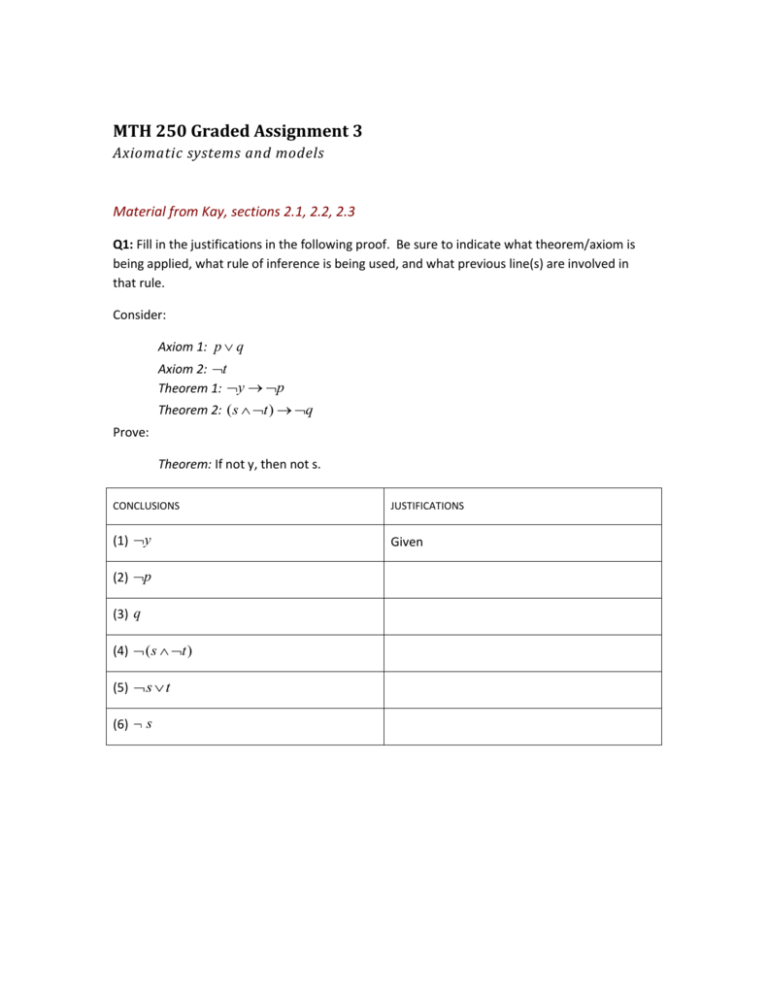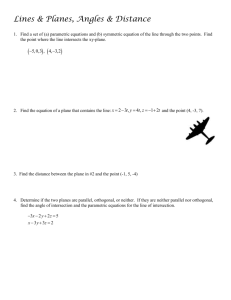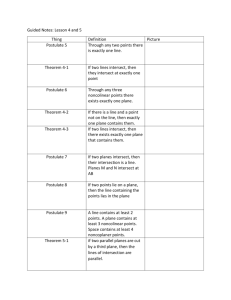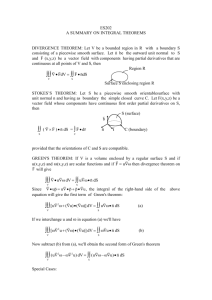As a Word .doc
advertisement

MTH 250 Graded Assignment 3
Axiomatic systems and models
Material from Kay, sections 2.1, 2.2, 2.3
Q1: Fill in the justifications in the following proof. Be sure to indicate what theorem/axiom is
being applied, what rule of inference is being used, and what previous line(s) are involved in
that rule.
Consider:
Axiom 1: p q
Axiom 2: t
Theorem 1: y p
Theorem 2: ( s t ) q
Prove:
Theorem: If not y, then not s.
CONCLUSIONS
JUSTIFICATIONS
(1) y
Given
(2) p
(3) q
(4) ( s t )
(5) s t
(6) s
Q2:
Consider:
Definition 1: a is b if and only if r implies s
Axiom 1: p q
Theorem 1: q implies a is b
Prove:
Theorem: (s p) r
Be sure to indicate in the justifications what theorem/axiom is being applied, what rule of
inference is being used, and what previous line(s) are involved in that rule. I’ll give you the first
step to get it going, and note that the number of lines there is accurate – it should take 7 steps
to the end.
CONCLUSIONS
JUSTIFICATIONS
(1) s p
Given
(2) p
Simplification of (1)
(7) r
Q3: Consider the following system of points, lines, and planes:
Points: S = {1,2,3,4}
Lines: {1,2,4}, {1,3}, {2,3,4}
Planes: {1,2,3}, {1,3,4}
Which incidence axioms [I-1 through I-5 in section 2.3] are satisfied in this system? Which are
not? Go through each incidence axiom and explain why it is/isn't satisfied. Assume that things
specified as distinct sets are intended to be distinct things (i.e. we could consider a trivial model
where the system collapses into just ONE line consisting of the points {1,2,3,4}, and the bits
about “non-collinear” points would be vacuously true since there aren’t any…but don’t do that).
I-1: Each two distinct points determine a line.
I-2: Three non-collinear points determine a plane.
I-3: If two points lie on a plane, then any line containing those two points lies in that plane.
I-4: If two distinct planes meet, their intersection determines a line.
I-5: Space consists of at least four non-coplanar points, etc. Each plane is a set of points of which
at least three are non-collinear, and each line is a set of at least two distinct points.
Q4: The 9-point affine plane. (See both Kay, p 76, #8, and the webpage on affine planes).
To answer this question, you must look at p 76 – this is where the lines for the 9 point plane are
defined as sets. The axioms themselves don't tell you what things are lines – the point sets that
make up the lines are part of the definition. Looking on page 76, you'll see that there are 12
defined lines, all of which contain three points. In your text, the points are lettered; here, they
are numbered, so all that remains is a translation. For example, the a defined line (in the text) is
{B,F,G}, so {2,6,7} (on this page) is a line. On the other hand, {6,5,8} (on this page) matches to {E,
F, H}, which is not one of the defined lines.
And, warning: it has come to my attention that some (but not all) texts have a typo in this
problem- if your text has l5 {B, E , F } listed as a line, this is incorrect (none of the lines turn
corners!). The correct set is l5 {B, E , H } .
Here is a model for a 9-point affine plane, corresponding to the model given on p 76
(a) In each of the diagrams shown below, a segment is highlighted and emphasized. For which
figures is the highlighted segment an actual line on the 9-point affine plane?
(i)
(ii)
(iii)
(iv)
(v)
(vi)
(b) How many lines exist which are parallel to the line {7,2,6}, and how do you know? (Hint:
there is a parallel for every ...). List all the lines on the plane which are parallel to {7,2,6}.
(c) Give three pairs of intersecting lines. Are there any lines that intersect in more than one
point?
(d) State the affine plane axioms (take them from the webpage, please) and verify (visually) that
this geometry satisfies them. [By "visually", I mean you do not have to explicitly construct lists of
all intersections as in the 4-point plane example, but you should describe what it is you'd look at
to verify each axiom, and assert that you've got it.]
Q5: Once we assume the incidence axioms I1-I5, we can then begin to prove theorems based on
them. One such theorem is named as “Theorem 2” in your text, and appears on page 73.
“Theorem 2” states:
If two distinct lines l and m meet, their intersection is a single point. If a line meets a
plane and is not contained by that plane, their intersection is a point.
The first part of the theorem (“If two distinct lines l and m meet, their intersection is a single
point.”) is proven in the text using a proof by contradiction. In a proof by contradiction, you
start by assuming that the original hypotheses are true, but also that the desired conclusion is
false. When it turns out that those two assumptions taken together contradict each other in
some way, you can then conclude that the initial assumption that the desired conclusion was
false can’t be correct, and therefore, the desired conclusion must be true after all.
The proof of the second part (“If a line meets a plane and is not contained by that plane, their
intersection is a point.”) is left as an exercise for the reader. So prove it! Proof will be similar to
the one the text shows for the first part – start by assuming there is a second point B which is
also in the intersection of the line and the plane (the opposite of the desired conclusion, which
says there’s only one point in the intersection), and show how that leads to a contradiction.
FWIW, while the logic in the textbook proof of part one is fine, I’m not a huge fan of that style of
presentation – feel free to write the proof in a more narrative form, with a bit more verbal
explanation; you don’t have to compact it that much. Be clear on which incidence axiom is
leading to a contradiction and why.
Q6: What are the differences between the affine plane axioms and the projective plane axioms?
In particular, in which geometry (affine or projective) do parallel lines exist, and in which
geometry are they impossible. Do either of the geometries have any concept for measuring
distance between points?
Q7: Describe what is happening to create the "paradox" in the Curry triangle dissection puzzle
shown below. In particular calculate the slopes of the line segments AB and BC in the first
figure and use that in your explanation. Why is the paradox not really a paradox?
In the first figure, point A is located at (0,0), point B is at (8,3), and point C is at (13,5).








